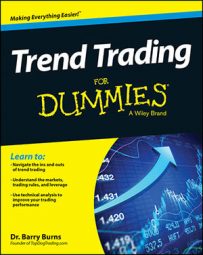To find the best time to enter a trade in the direction of the trend, you need an objective instrument that helps you measure cycles accurately. The best you can realistically hope for is to develop a tool that puts the odds on your side. It won’t give you perfect certainty, but it can give you a probability scenario that favors you.
The stochastic indicator isn’t a timing tool
The stochastic indicator, created by Dr. George Lane, is an oscillator that’s actually designed to measure momentum, not cycles. More specifically, it measures the current closing price in relation to its price range over a defined period of time in the past. The most common period of defined past time is 14 bars.
The indicator assumes that markets with upward momentum tend to close near the highs and that markets with downward momentum tend to close near their lows. The indicator is a bounded indicator in that the mathematic formula of the indicator allows it to reach a maximum value of 100 and a minimum value of 0.
In other words, the indicator never goes above a reading of 100 or below a reading of 0, no matter how much the market it’s measuring moves up or down.
The stochastic indicator is comprised of two lines:
The %K line measures the value of the stochastic calculation. In the figure, %K is the thin line that moves faster.
The %D line is a three-period exponential moving average of %K. In the figure, %D is the slower, thick line.
![[Credit: Figure by Barry Burns]](https://www.dummies.com/wp-content/uploads/448332.image0.jpg) Credit: Figure by Barry Burns
Credit: Figure by Barry Burns
The indicator also has two horizontal lines that are usually placed at the values of 20 and 80, indicating oversold and overbought areas, respectively.
You can get a sense of the cycles in the market by looking at the highs and lows of the oscillations of the indicator. The crossing of %K above and below %D also helps to visually identify the cycle highs and lows.
However, if you study a large sample of market data and look at the indicator in relation to price movement, you’ll notice that it’s often a bit late. Also, in strongly trending markets, it doesn’t locate as many cycle highs and lows as you may like.
The following figure provides an example of how the traditional settings of the stochastic indicator can produce few cycle high and low signals when the market is trending.
![[Credit: Figure by Barry Burns]](https://www.dummies.com/wp-content/uploads/448333.image1.jpg)
Optimizing the timing tool for optimal entries
The solution to turning the stochastic oscillator into a cycle indicator that gives you more opportunities to buy and sell is to simply shorten the time it measures by changing the inputs of the indicator. The default settings you have on your charting software may vary. Here are the recommended settings:
Period D (%D): 3
Period K (%K): 5
Smoothing (Average): 2
The result of these changes is to simply create more highs and lows on the indicator so that instead of measuring long-term momentum, the indicator measures short-term oscillations in the market.
![[Credit: Figure by Barry Burns]](https://www.dummies.com/wp-content/uploads/448334.image2.jpg)
Shortening the parameters of the indicator clearly creates more instances where the indicator reaches overbought and oversold levels, thus potentially providing more buy and sell signals.

